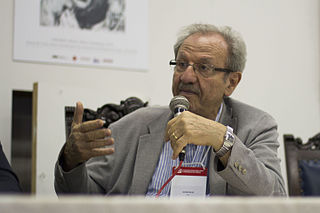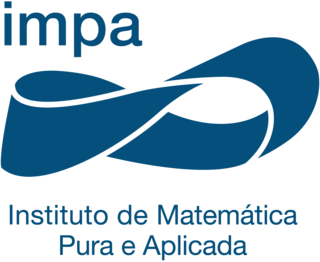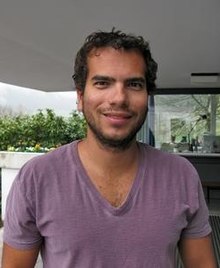
Jacob Palis Jr. is a Brazilian mathematician and professor. Palis' research interests are mainly dynamical systems and differential equations. Some themes are global stability and hyperbolicity, bifurcations, attractors and chaotic systems.

The Instituto Nacional de Matemática Pura e Aplicada is considered to be the foremost research and educational institution of Brazil in the area of mathematics. It is located in the city of Rio de Janeiro, and was formerly known simply as Instituto de Matemática Pura e Aplicada (IMPA), whose abbreviation remains in use.

Claire Voisin is a French mathematician known for her work in algebraic geometry. She is a member of the French Academy of Sciences and holds the chair of algebraic geometry at the Collège de France.

Maurício Matos Peixoto,, was a Brazilian engineer and mathematician. He pioneered the studies on structural stability, and was the author of Peixoto's theorem.

Elon Lages Lima was a Brazilian mathematician whose research concerned differential topology, algebraic topology, and differential geometry. Lima was an influential figure in the development of mathematics in Brazil.

Aron Simis is a mathematician born in Recife, Brazil in 1942. He is a full professor at the Universidade Federal de Pernambuco, Brazil, and Class A research scholarship recipient from the Brazilian Research Council. He earned his PhD from Queen's University, Canada.
The Brazilian Mathematical Olympiad is a mathematics competition held every year for students of Brazil. The participants are awarded gold, silver and bronze medals in accordance with their performance. The main purpose of this competition is to help in selecting students to represent Brazil at the International Mathematical Olympiad.

Welington Celso de Melo was a Brazilian mathematician. Known for his contributions to dynamical systems theory, he served as full professor at Instituto Nacional de Matemática Pura e Aplicada from 1980 to 2016. Melo wrote numerous papers, one being a complete description of the topological behavior of 1-dimensional real dynamical systems . He proved the global hyperbolicity of renormalization for Cr unimodal maps. He was a recipient of the 2003 TWAS Prize.

Vincent Lafforgue is a French mathematician who is active in algebraic geometry, especially in the Langlands program, and a CNRS "Directeur de Recherches" at the Institute Fourier in Grenoble. He is the younger brother of Fields Medalist Laurent Lafforgue.

The Brazilian Mathematical Olympiad of Public Schools (OBMEP) is an annual Mathematics contest created in 2005 by the Brazilian Ministério da Ciência e Tecnologia (MCT) and Ministério da Educação (MEC), in collaboration with Instituto Nacional de Matemática Pura e Aplicada (IMPA) and Sociedade Brasileira de Matemática (SBM), to stimulate the mathematics education in Brazil. It is open to public school students from fifth grade to high school. Yearly, around 18 million students are enrolled for its first round.
This is a timeline of women in mathematics.

Fernando Codá dos Santos Cavalcanti Marques is a Brazilian mathematician working mainly in geometry, topology, partial differential equations and Morse theory. He is a professor at Princeton University. In 2012, together with André Neves, he proved the Willmore conjecture. Since then, among proving other important conjectures, Marques and Neves greatly extended Almgren–Pitts min-max theory to prove theorems about minimal surfaces.

Marcelo Miranda Viana da Silva is a Brazilian mathematician working in dynamical systems theory. He proved the Zorich–Kontsevich conjecture together with Artur Avila.
Ricardo Mañé Ramirez was a Uruguayan mathematician, known for his contributions to dynamical systems and ergodic theory. He was a doctoral student of Jacob Palis at IMPA.

Svetlana Yakovlevna Jitomirskaya is a mathematician working on dynamical systems and mathematical physics. She is a distinguished professor of mathematics at Georgia Tech and UC Irvine. She is best known for solving the ten martini problem along with mathematician Artur Avila.
Carlos Gustavo Tamm de Araújo Moreira is a Brazilian mathematician working on dynamical systems, ergodic theory, number theory and combinatorics. Moreira is currently a researcher at the Instituto Nacional de Matemática Pura e Aplicada (IMPA), where he goes by the nickname "Gugu". He is also a member of the Brazilian Mathematical Olympiad Commission, a fanatic fan of the Brazilian football team Flamengo and a member of the Brazilian Communist Party (PCB). In October 2016, he achieved the mark of 5000 goals scored in his amateur football career. He maintains a record of his goals to show to the incredulous.
Jorge Manuel Sotomayor Tello was a Peruvian-born Brazilian mathematician who worked on differential equations, bifurcation theory, and differential equations of classical geometry.

César Leopoldo Camacho Manco, better known as simply César Camacho, is a Peruvian-born Brazilian mathematician and former director of the IMPA. His area of research is dynamical systems theory.
Arnaldo Leite Pinto Garcia is a Brazilian mathematician working on algebraic geometry and coding theory. He is a titular researcher at the IMPA.
The Olimpíada de Matemática do Grande ABC, or OMABC is a mathematical competition for pre-collegiate Brazilian students of Grande ABC region, composed by the following cities:














